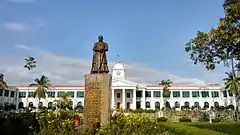Kerala Government Secretariat
The Kerala Government Secretariat (Malayalam: Saṁsthāna Sarkkār Sirākēndraṁ) is the seat of administration of the Government of Kerala, in Thiruvananthapuram, housing important ministries and bureaucratic offices.[1][2] It is the highest echelon of state administrative structure offering locus for the exercise of authority by state Government. The secretariat refers to the complex of departments. Its political heads are the ministers while the administrative heads are the Secretaries to the Government. The Government Secretariat is a popular landmark and located in heart of the Thiruvananthapuram City, in Narmada Road. The Secretariat complex was originally constructed as Durbar Hall for Travancore Kingdom.
| Government Secretariat Building | |
|---|---|
കേരള സംസ്ഥാന ഭരണ സിരാ കേന്ദ്രം | |
 | |
  | |
| Former names | Huzur, Puthen Kacheri |
| General information | |
| Architectural style | Roman and Dutch, among others |
| Location | Thiruvananthapuram, Kerala, India |
| Coordinates | 8.4972°N 76.9495°E |
| Construction started | 1865 |
| Completed | 1869 |
| Owner | Government of Kerala |
| Design and construction | |
| Architect | Barton |
History
Over 150 years old, the building's foundation stone was laid by His Highness Ayilyam Thirunal, the Maharaja of Travancore in 1865 and was completed in 1869. The original structure was planned to accommodate Travancore Royal Durbar Hall where the King meets his council of ministers on a monthly basis apart from the offices of Peshkars (Secretaries of the State). It was designed and built under Barton, the then chief engineer of Travancore and incorporates elements of Roman and Dutch architecture.[3] The construction was supervised by the then Dewan, T. Madhava Rao, whose statue now stands across the road opposite the building.[4]
His Highness Chithira Tirunal, the last king of Travancore, was crowned king in a ceremony held at the Secretariat. The Secretariat also housed the Kerala State Legislative Assembly from 1939 before it moved to the new building.[5] Lord Willingdon, the then Viceroy laid the foundation stone for the new Assembly Building on 12 December 1933 and it was opened on 6 February 1939 by Dewan Sir C. P. Ramaswami Iyer and the Second Sri Mulam popular Assembly convened in this building that year.[6]
Known during the princely era as the Huzur or Puthen Kacheri, it was renamed the Government Secretariat in 1949. The Secretariat is the nerve centre of Kerala's governance and hence is also the site of political protests and it often witnesses marches and demonstrations outside its walls.
Structure

Kerala Secretariat Complex consists of 3 blocks. The central block is the oldest structure. The Central Block has main door known as Ana Kavadam (Elephant Door), which opens to the grand Durbar Hall. This Durbar hall earlier was used only by Travancore Maharaja and his courtiers with limited public entry. Today the Durbar Hall is converted into State Ceremonies Hall where public meetings and state ceremonies are held.
There are 20 doors located in either side of the Durbar Hall. The Central block has 2 stories and houses offices of various departments. The Old Assembly Hall is located in ground floor of the Central Block at the right, which is now converted into a public legislative museum, depicting the legislative history of Kerala.[7] There are plans to introduce Kerala Institute of Parliamentary Affairs to this complex.[8]
Apart from the central block, two new blocks, North Block and South block, were constructed on either side of the central block. The South block was opened by the then Hon. Chief Minister of Kerala Sri. Pattom A. Thanupillai on 18 August 1961. Later two "Sandwich" blocks were also constructed in between the central and the new blocks. The North Block, located at North Gate, houses office of the Hon. Chief Minister of Kerala, offices of a few cabinet ministers and cabinet room. The South Sandwich Block and North Sandwich Block houses primarily offices Government secretaries, though a few offices of ministers are located here due to congestion in north block.
Departments
Kerala Secretariat complex houses offices of various state government department. The business of the State Government is transacted through the following Secretariat Department based on the Kerala Secretariat Rules of Business (KSRB).[9]
- Agriculture Department
- Co-operation Department
- Cultural Affairs Department
- Election Department
- Finance Department
- Fisheries and Ports Department
- Food and Civil Supplies Department
- Forests and Wild Life Department
- General Administration Department
- General Education Department
- Health and Family Welfare Department
- Higher Education Department
- Home Department
- Housing Department
- Industries Department
- Information Technology Department
- Irrigation Department
- Labour and Rehabilitation Department
- Law Department
- Local Administration Department
- Personnel and Administrative Reforms Department
- Planning and Economic Affairs Department
- Power Department
- Public Works Department
- Transport Department
- Revenue Department
- Rural Development Department
- Scheduled Castes and Scheduled Tribes Development Department
- Science, Technology and Environment Department
- Social Welfare Department
- Stores Purchase Department
- Taxes Department
- Vigilance Department
References
| Wikimedia Commons has media related to Kerala Government Secretariat. |
- Archived 1 January 2009 at the Wayback Machine
- Archived 5 October 2010 at the Wayback Machine
- "Archived copy". Archived from the original on 3 April 2009. Retrieved 4 February 2010.CS1 maint: archived copy as title (link)
- What the Statues Tell: The Politics of Choosing Symbols in Trivandrum, Robin Jeffrey, Pacific Affairs, Vol. 53, No. 3 (Autumn, 1980), pp. 484-502, p.486
- "Kerala Secretariat in Thiruvananthapuram India". India9.com. 7 June 2005. Retrieved 20 October 2013.
- "History of legislative bodies in Kerala- bicameralism". Keralaassembly.org. Retrieved 20 October 2013.
- Archived 28 November 2009 at the Wayback Machine
- "Government Departments - Kerala Info @ New Kerala .Com". Kerala-info.newkerala.com. Retrieved 20 October 2013.